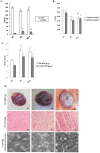Atorvastatin Attenuates Metabolic Remodeling in Ischemic Myocardium through the Downregulation of UCP2 Expression
- PMID: 29559841
- PMCID: PMC5859775
- DOI: 10.7150/ijms.22454
Atorvastatin Attenuates Metabolic Remodeling in Ischemic Myocardium through the Downregulation of UCP2 Expression
Abstract
Uncoupling protein 2 (UCP2) is primarily expressed in the myocardium and is closely related to myocardial ischemia/reperfusion injury and myocardial metabolism. To explore the effects and the mechanisms of UCP2 on atorvastatin-mediated myocardium protection, the rat model of myocardial ischemia was established by ligation of the left anterior descending coronary arteries (LADs). The rats were divided into the sham operation (SO) group, myocardial infarction (MI) group and MI-atorvastatin group. The study that atorvastatin reduced myocardial remodeling and improved the disturbed myocardial energy metabolism after MI. Furthermore, the mechanisms of myocardial metabolic remodeling affected by atorvastatin were explored. The atorvastatin group showed a significantly decreased expression of UCP2 mRNA and protein. Furthermore, the primary rat cardiomyocytes were cultured and treated with angiotensin II (Ang II) to induce cardiomyocyte hypertrophy. The results showed that in the atorvastatin group, the surface area of the cardiomyocytes, the total protein content per unit of cells, and the expression of the UCP2 protein were significantly decreased. These data suggested that atorvastatin significantly attenuated the myocardial remodeling by downregulating the expression of UCP2 that was found to improve the myocardial energy metabolism, inhibit myocardial hypertrophy, and eventually reduce myocardial remodeling.
Keywords: atorvastatin; heart failure; metabolic remodeling; uncoupling proteins-2.
Conflict of interest statement
Competing Interests: The authors have declared that no competing interest exists.
Figures




Similar articles
-
Atorvastatin Improves Ventricular Remodeling after Myocardial Infarction by Interfering with Collagen Metabolism.PLoS One. 2016 Nov 23;11(11):e0166845. doi: 10.1371/journal.pone.0166845. eCollection 2016. PLoS One. 2016. PMID: 27880844 Free PMC article.
-
Atorvastatin reduces myocardial fibrosis in a rat model with post-myocardial infarction heart failure by increasing the matrix metalloproteinase-2/tissue matrix metalloproteinase inhibitor-2 ratio.Chin Med J (Engl). 2013;126(11):2149-56. Chin Med J (Engl). 2013. PMID: 23769575
-
Cardioprotective effect of polydatin on ventricular remodeling after myocardial infarction in coronary artery ligation rats.Planta Med. 2015 May;81(7):568-77. doi: 10.1055/s-0035-1545907. Epub 2015 Apr 23. Planta Med. 2015. PMID: 25905591
-
Pathobiology of myocardial and cardiomyocyte injury in ischemic heart disease: Perspective from seventy years of cell injury research.Exp Mol Pathol. 2024 Dec;140:104944. doi: 10.1016/j.yexmp.2024.104944. Epub 2024 Nov 21. Exp Mol Pathol. 2024. PMID: 39577392 Review.
-
miRNAs as therapeutic targets in ischemic heart disease.J Cardiovasc Transl Res. 2010 Jun;3(3):280-9. doi: 10.1007/s12265-010-9173-y. Epub 2010 Mar 30. J Cardiovasc Transl Res. 2010. PMID: 20560049 Review.
Cited by
-
Functional Implications of HMG-CoA Reductase Inhibition on Glucose Metabolism.Korean Circ J. 2018 Nov;48(11):951-963. doi: 10.4070/kcj.2018.0307. Korean Circ J. 2018. PMID: 30334382 Free PMC article. Review.
-
Crosstalk among Reactive Oxygen Species, Autophagy and Metabolism in Myocardial Ischemia and Reperfusion Stages.Aging Dis. 2024 May 7;15(3):1075-1107. doi: 10.14336/AD.2023.0823-4. Aging Dis. 2024. PMID: 37728583 Free PMC article. Review.
-
Identification of energy metabolism-related biomarkers for risk prediction of heart failure patients using random forest algorithm.Front Cardiovasc Med. 2022 Oct 11;9:993142. doi: 10.3389/fcvm.2022.993142. eCollection 2022. Front Cardiovasc Med. 2022. PMID: 36304554 Free PMC article.
-
Danqi Pill Protects Against Heart Failure Post-Acute Myocardial Infarction via HIF-1α/PGC-1α Mediated Glucose Metabolism Pathway.Front Pharmacol. 2020 Apr 21;11:458. doi: 10.3389/fphar.2020.00458. eCollection 2020. Front Pharmacol. 2020. PMID: 32372956 Free PMC article.
-
Targeting ferroptosis as a promising therapeutic strategy to treat cardiomyopathy.Front Pharmacol. 2023 Apr 13;14:1146651. doi: 10.3389/fphar.2023.1146651. eCollection 2023. Front Pharmacol. 2023. PMID: 37138856 Free PMC article. Review.
References
-
- Tuomainen T, Tavi P. The role of cardiac energy metabolism in cardiac hypertrophy and failure. Exp Cell Res; 2017. Mar 24. pii: S0014-4827(17)30178-7. - PubMed
-
- van Bilsen M1, Smeets PJ, Gilde AJ. et al. Metabolic remodelling of the failing heart: the cardiac burn-out syndrome? Cardiovasc Res. 2004;61:218–226. - PubMed
-
- Peterzan MA, Lygate CA, Neubauer S. et al. Metabolic remodelling in hypertrophied and failing myocardium: a review. Am J Physiol Heart Circ Physiol. 2017;313(3):H597–H616. - PubMed
-
- De Jong KA, Lopaschuk GD. Complex Energy Metabolic Changes in Heart Failure With Preserved Ejection Fraction and Heart Failure With Reduced Ejection Fraction. Can J Cardiol. 2017;33:860–871. - PubMed
MeSH terms
Substances
LinkOut - more resources
Full Text Sources
Other Literature Sources
Medical
Miscellaneous

